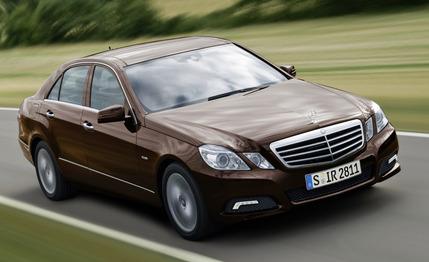
 First Drive Review
First Drive Review
The Mercedes-Benz E-class is the sedan that bridges the showroom gap between the six-figure S-class and the $30,000 C-class. Without the E, the Mercedes lineup would simply encompass two extremes of luxury sedans, with a bunch of SUVs occupying the space between.
Mercedes has thoroughly redone its mid-size E-class range for 2010. Thoroughly means this is not a mere styling refresh; but the design indeed has evolved, and it’s the most obvious change. For its past two generations, the E-class has worn four oval-shaped headlights, a look that became iconic enough for the Koreans to copy it on the Kia Amanti and the previous Hyundai Sonata. The ovoids are gone now, replaced by four parallelogram-shaped lamps that look unique but still make sense on an E-class. The change from soft shapes continues to the roofline, as the new car is more angular and creased more sharply than before. Those creases have drawn some flack for what happens to the rear fender, but photos don’t do the back end justice. The roundness of the rear fender flare and the horizontal line that sits above work far better in person than in a two-dimensional photograph.
Changes Are More Than Skin Deep
Under the new skin is an entirely new steel unibody structure. A few sprinklings of aluminum are present in the front fenders, hood, radiator support, and steering column bracket, but the E-class remains a steel-intensive vehicle. Not surprisingly, overall weight is expected to increase from the 3740 pounds the company claimed for the previous E350. However, Mercedes is quick to point out that the E’s new structure passes future crash legislation and enjoys a 30-percent improvement in structural rigidity. Over the road, the structure feels silent and quiver-free, but the same could be said of the previous model.
Mercedes has resisted making the E-class a larger car. Overall length is 191.7 inches, an increase of 0.7 inch, and the wheelbase measures 113.1 inches, again a growth of 0.7 inch. Subjectively, interior volume seems about the same as the previous generation’s. The more upright roofline adds a few fractions of an inch to front and rear headroom, and rear legroom is up slightly, but the difference is negligible. Trunk space, however, is up 2.2 cubic feet to 19.1.
So there’s not a lot more space inside, but what really separates the new E’s interior from its progenitor’s is the new look. Inside is where the E-class’s reconciliation between the C-class and S-class truly occurs. Many elements look as if they were borrowed from the more luxurious S-class; the column shifter, the center armrest and console, the LED lighting that glows at night, and the quality of the materials are all very close to what is found in the bigger Benz. What appear to be from the C-class—or at least similar to the items in the C-class—are the knob that controls the COMAND infotainment system, the radio buttons, and the instrument gauges. Exclusive to the E are new seats that have more padding and feel more supple and richer than the previous car’s thrones.
Same Power, New Feel
What hasn’t changed is what powers the E-class. When the car goes on sale in the U.S. this July, two engines will be offered: a 268-hp, 3.5-liter V-6 and a 382-hp, 5.5-liter V-8. Both engines are connected to a seven-speed automatic transmission. Our drive concentrated on the E550 (or E500, as it is known in Europe). After the introduction of the E550 and E350, an E350 wagon, 4MATIC all-wheel drive, and the E63 AMG variants will join the lineup. Models equipped with 4MATIC will get the seven-speed automatic for the first time, and in 2010, the 50-state-legal 3.0-liter V-6 turbo-diesel returns.
Driving the latest E-class reveals a familiar character, but it doesn’t take long to realize that something is different. Steering accuracy is better and more BMW-like. Some of the sluggishness of the previous E-class’s helm has been ousted and replaced with more responsive tuning. Consequently, the car feels more alive. The slightly lethargic feel of the previous car, like the low-mounted turn signal stalk, was long a Mercedes trait and something we’d come to expect from the E-class. Some of the creaminess of the ride and steering is left, but it feels like the car is on a smaller dose of Vicodin than before.